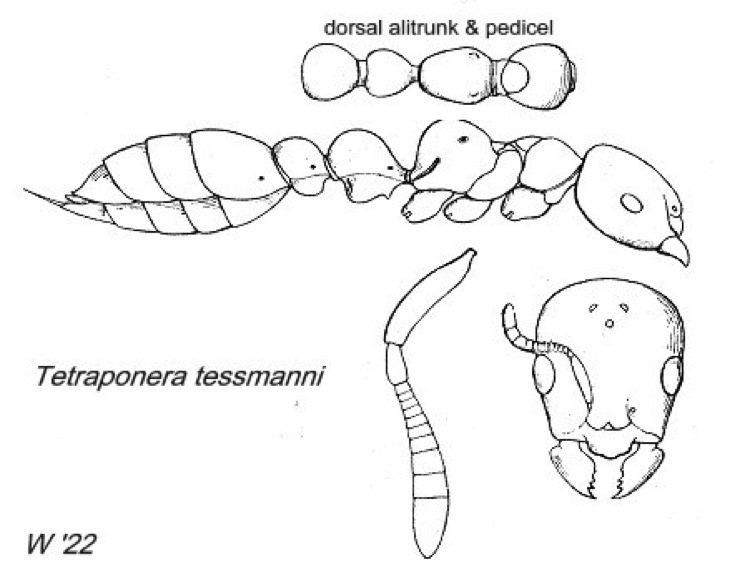Tetraponera tessmanni (Stitz)
  Type location Equatorial
Guinea (Sima tessmanni n. sp., Stitz, 1910: 131,
illustrated, worker; Santschi, 1919h: 84, queen; Wheeler, 1922: 110,
male; in Tetraponera, Ward, 1990: 489) collected at Alen, by
Tessmann - see below: type queen at https://www.antweb.org/specimenImages.do?code=focol1166 Type location Equatorial
Guinea (Sima tessmanni n. sp., Stitz, 1910: 131,
illustrated, worker; Santschi, 1919h: 84, queen; Wheeler, 1922: 110,
male; in Tetraponera, Ward, 1990: 489) collected at Alen, by
Tessmann - see below: type queen at https://www.antweb.org/specimenImages.do?code=focol1166
junior synonym
castanea (Viticola
tessmanni variety castanea,
new variety, Wheeler,
1922: 112, worker & queen) from Zaïre, at Avakubi,
by Lang & Chapin; synonymy by Brown, 1950e: 248) - see below
worker, male and
queen described (see Bolton, 1995)  . .
|
 Description and
illustration from Wheeler (1922) Description and
illustration from Wheeler (1922)
WORKER -
Length 3 to 3.5 mm. Head longer than broad, a little broader behind
than in front, with feebly concave cheeks, rounded posterior corners
and nearly straight posterior border, and, on the vertex, with a short
longitudinal impression at one end of which the anterior ocellus is
sometimes distinctly developed. Posterior ocelli absent. Eyes very
small, flat, shorter than half their distance from the mandibular
insertions, placed a little in front of the middle of the head.
Mandibles short, rather strongly angulate at the base externally, their
apical margins oblique, with 5 or 6 denticles, those at the base often
indistinct. Clypeus convex and evenly rounded in the middle, its
anterior border projecting, entire, strongly emarginate on the sides.
Frontal groove absent. Antennae short, scapes not reaching to the
middle of the head, first funicular joint much longer than broad,
joints 2 to 8 much broader than long, crowded together, joints 9 to 11
forming a three-jointed club, the last joint being as long as both the
others, which are subequal and somewhat broader than long. Thorax
narrower than the head, constricted in the mesonotal region. Pronotum
from above a little broader than long, evenly rounded and convex;
mesonotum transversely subelliptical, feebly convex, surrounded by
impressed sutures. Metanotum nearly as long as the mesonotum, concave,
with uneven surface. Propodeum very convex and rounded, egg-shaped from
above, semiglobose in profile, as high as the pronotum or slightly
higher, with the slit-shaped epinotal glands shining through the
integument and conspicuously enlarged. Petiole short, scarcely longer
than broad, broader behind than in front, convex and rounded above. In
profile, its ventral surface is also convex and protuberant, with a
small, compressed, blunt, translucent tooth anteriorly. Postpetiole a
little broader than the petiole, scarcely broader than long and
scarcely broader behind than in front, convex and rounded above and
below. Legs and gaster of the usual shape, the latter with
well-developed sting.
Very smooth and shining, including the mandibles; impunctate under a
magnification of 20 diameters. Hairs golden yellow, erect, of uneven
length, sparse, most numerous on the gaster, especially along its
sides. These regions also have more numerous short hairs or suberect
pubescence. Antenna and legs with shorter, more appressed hairs. Cheeks
and clypeus densely and conspicuously pubescent, the latter without a
fringe of cilia-like bristles.
Clear brownish yellow, with the borders of the mandibles, clypeus and
frontal carinae brown. The variety castanea was morphologically
similar but the body and legs were pale chestnut brown, with the
antennae paler and more yellowish.
Wheeler (1922) described how several hundred specimens
were taken at Medje, Zaïre, by Mr Lang, from the hollow stems of Vitex
staudtii Guerke. In the report of the Lang-Chapin expedition there
also is much information on the relation between the ant and the plant
(Bequaert in Wheeler, 1922, p 447) and on the woody structure of the
plant (by Professor Bailey, in Wheeler, pp 585-593 & 605-6) (see Ant Plants).
|